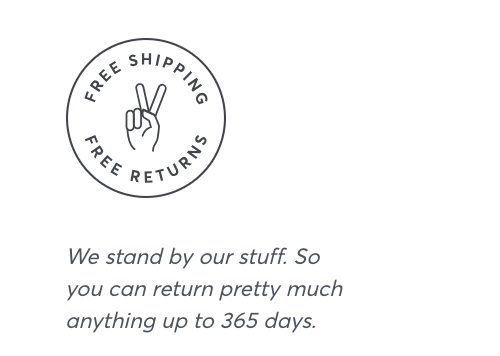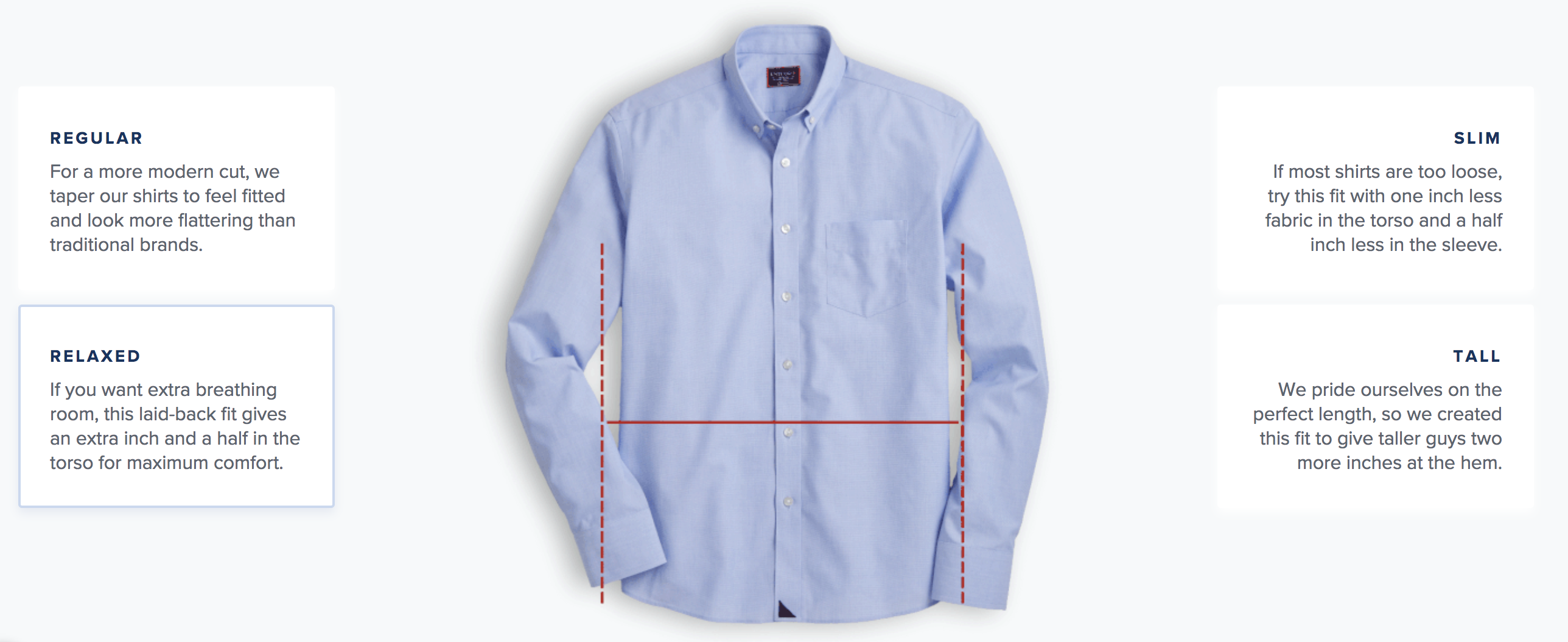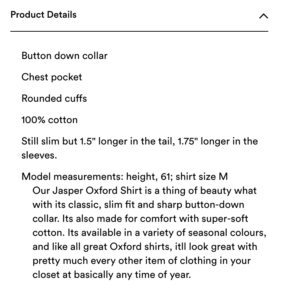What do I mean by confident brand? An easy way to answer this question is to present the case of a brand that lacks confidence.
Here are a few examples;
- pop-ups that offer me a 10% discount before I’ve had a chance to even see the products you sell
- no product reviews (for fear, god forbid, that somebody may give you 3 stars) but plenty of talk of ‘great service’ (yawn)
- every product you can think of thrown up on the homepage (because you haven’t the confidence to focus in on one particular line)
- a distinct lack of tone or personality in your product descriptions. Just the same flat words I can find on any other clothing brand site eg. talk of comfort and style. People deserve more.

Confidence breeds confidence. And people, your website visitors, need to feel confident in buying what they buy from you.
Take this example from Marine Layer. It’s a simple message ‘We stand by our stuff’ set into the navigation footer. A single sentence that demonstrates the kind of brand you’re buying from. A brand that stands by the stuff they make. I love it.
A confident brand reflects the general attitude of the people behind the brand.
The instant 10% offer popup? Pushy? Desperate? Attention seeking? Remember. Your task is helping people to buy. Be careful how you present that discount code.
When you lack confidence in a certain subject there’s a tendency to ramble on. Nerves take over. It’s the same scenario for website copy. Take your about us page as an example. Is it clear and to the point. Do you draw me a picture of why your clothing brand exists? There is a reason, isn’t there? Then let’s share that reason with the world.
I’m not too concerned about reading your desire to perfect customer service or your unflinching focus on exemplary standards. You and the rest of the fashion world. Instead, I want to hear about that moment when the idea was born. The thousand hours research that went into the garments you now make. Back stories, side stories, front stories. Whatever. It doesn’t matter what you call it. Just make me feel warmer towards your brand when I finish reading your brand bio than I did at the start.
Whatever brought your business into existence is a story you should be proud to tell. No matter how silly it may sound to you, that level of honesty and openness gives you a connection point to your website customer. Take advantage.
What drives a confident brand?
We’re fed articles, books and seminars that talk of the rewards of purpose-driven, mission-driven, data-driven, pixie-dust-driven brands. Don’t become fixated with the prefix. Being driven to be a better business is good enough for me and your customers. Your next job is to demonstrate that drive.
Confidence comes through knowledge. Share that knowledge
You know your designs, your fabrics, your silhouettes better than anyone. That puts you in a position of authority. If customers have questions, often unasked questions, then your job is to pre-empt.
The most common questions relate to size. One man’s slim-fit is another man’s regular. As they say.
Untuckit.com present their customer’s with a brilliant explanation of their styles. Nothing laboured, just singe sentence explanations of the 4 fit variants they offer:

Armed with insight, your website visitor is now ready to proceed with confidence. That insight comes from you. A confident brand speaks with clarity. No waffle.
It’s the copy you write that converts website browsers into paying customers
I’ve been involved with countless a/b tests. Want to know the correct colour for a buy now button? I have absolutely no idea. Why? Colour choices don’t shift the needle. Split-testing copy does. The most valuable a/b tests that provide genuine results and real learning are those focusing in on website copy.
- Where you introduce copy – building trust or creating distraction?
- Copy length – short or long form?
- Copy personality – emotive vs statement?
- Voice – yours or your customers?
- Value proposition – what motivates people to click?
I’ve seen fashion brands jump from new website to new platform to new website on a yearly schedule. The reason? The site’s not ‘working’ as effectively as they anticipated. It’s the platform’s fault, right? I’ve worked with some pretty shitty platforms that are converting customers at rates highly-invested brands could only dream of. In similar markets. With similar price points. With similar load speeds.
The cause? The laser like focus on website copy. The intent? To demonstrate a brand that is confident in it’s clothing and confident in the feel good factor that clothing will deliver.
Apps or words? Where is your focus?
I’m witnessing app-acquisition syndrome at clothing brands. Shopify is a breeding ground. Fashion marketing managers who are spending their days launching new apps with the objective of influencing more people to shop. Countdown timers. Triggered messages. Rotating, blending, bouncing, fading carousels. All apps invested in with good intent. The problem being the sheer abundance of marketing apps placed live without consideration for the message they carry (or the additional load time that frustrates the hell out of your site visitors). Like the addition of one further app will unshackle conversion rates and drive wild levels of growth. It doesn’t happen like that.
A bucket-load of apps is the equivalent of TURNING CAPS LOCK ON!!! LOOK AT ME!!!! We’re trying our damnedest to win the attention of our site visitors. A plethora of message delivery mechanisms missing the poignancy of a succinct focused (and creative) message.
When you’re stuck for something to say this is what’s usually said

“a thing of beauty what with its classic, slim fit and sharp button-down collar. Its also made for comfort with super-soft cotton. Its available in a variety of seasonal colours, and like all great Oxford shirts, it’ll look great with pretty much every other item of clothing in your closet at basically any time of year“.
STFU.
A shirt. Made for comfort? Well I never….
How do Untuckit.com describe their Oxford shirt?
“It’s woven from simply gorgeous cotton poplin that’s thin enough to wear in sweltering heat, yet durable enough to get you comfortably through the winter months.”
The mumbling salesman versus the confident salesman who knows what sells a shirt. Succinct detail influences purchase.
Closing comments
It’s one of the most difficult jobs in ecommerce. Staring at an item and wondering what the hell you’re going to write about it. It’s a shirt. What can you say?!
Take each of those product features that you’ve bullet-pointed. Now, write a single sentence under each ‘designed so that you can…’ now complete that sentence. Then go back and remove the naff ‘designed so that you can….’ You’ve just answered the question your customer needs to know. It’s called context. Context is a very powerful tool. Only ever beaten when it’s blended with a dose of empathy.
When you review your site and your site’s success you’re immediately attracted to the user experience. Where things are positioned and what happens when people click things.
With the standardisation of ecommerce sites across the major platforms user experience is making great strides. Single page checkouts. Better navigation. Quicker download speeds and great accessibility. The one thing in your complete control is the words that you write.
Those words need to be written and presented with confidence. With your customer in mind. And a handful of their questions that you’re ready to answer.

